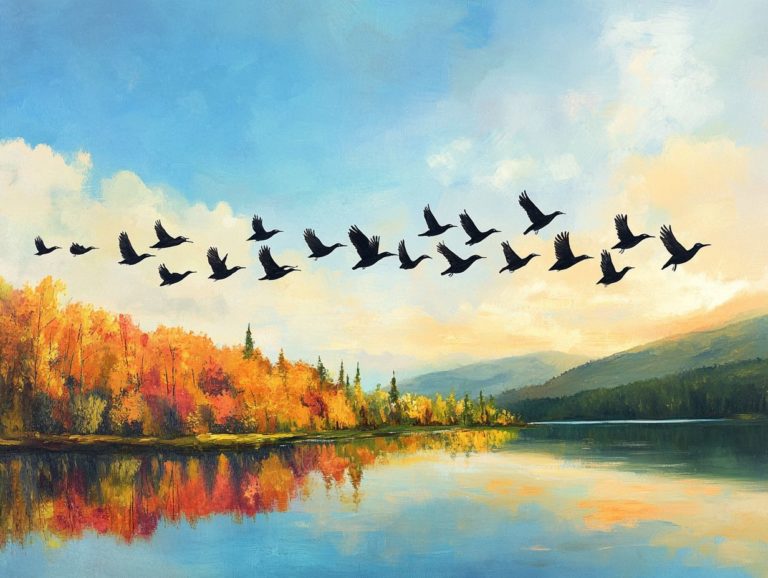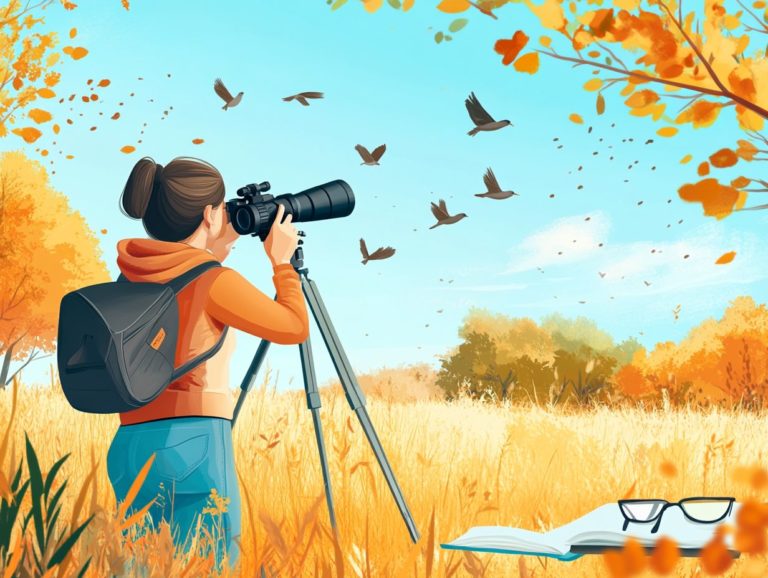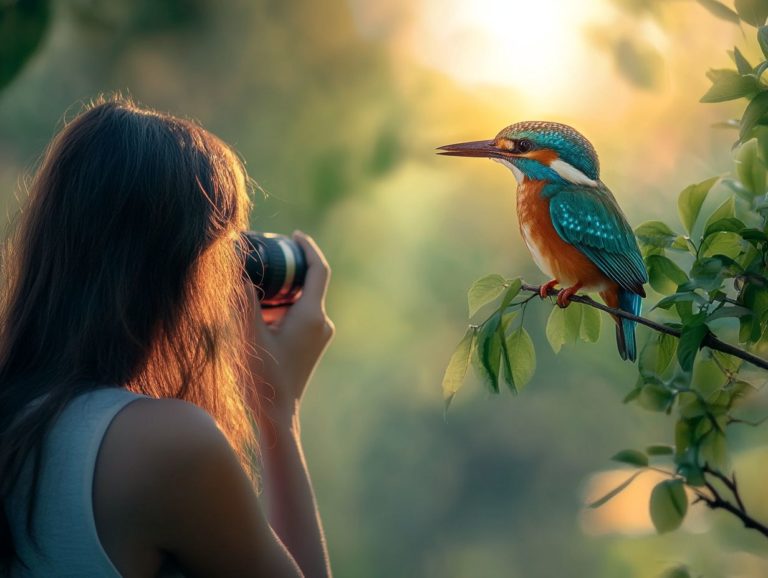8 Common Bird Watching Mistakes and How to Avoid Them
Bird watching is a rewarding and exciting hobby. However, even the most experienced bird watchers can make easily avoidable mistakes that detract from the experience.
Insufficient research on bird species and their natural habitats, as well as improper use of equipment, are two common errors that can limit one’s enjoyment and appreciation of birds.
This article explores eight of the most frequent bird watching mistakes and offers valuable tips on how to enhance your birdwatching techniques and skills.
Discover how patience, attentiveness, and engagement with birdwatching groups can lead to more fulfilling bird watching experiences!
Contents
- Key Takeaways:
- 1. Not Doing Proper Research on Bird Species and Habitats
- 2. Not Knowing How to Properly Use Binoculars and Other Equipment
- 3. Not Being Patient Enough
- 4. Not Paying Attention to Bird Behavior and Calls
- 5. Not Being Mindful of Your Surroundings
- 6. Not Respecting the Birds and Their Habitats
- 7. Not Keeping a Record of Your Observations
- 8. Not Joining a Bird Watching Group or Community
- How Can Bird Watching Enthusiasts Avoid These Common Mistakes?
- Frequently Asked Questions
- What are the most common mistakes bird watchers make?
- How can I avoid not having the right equipment?
- What can happen if I don’t research the location?
- What will I learn by watching bird behavior closely?
- How can I maintain proper personal hygiene while bird watching?
- What is the key to successful bird watching?
- Why is it important to respect wildlife while bird watching?
Key Takeaways:
- Proper research and preparation can enhance your bird watching experience and help you spot more bird species.
- Knowing how to use binoculars, and being patient and observant are key to successful birdwatching outings.
- Being mindful and respectful of birds and their habitats is crucial for their well-being and your own safety.
1. Not Doing Proper Research on Bird Species and Habitats
Researching bird species and their habitats is crucial. Without this knowledge, you might miss out on a fulfilling bird-watching experience.
Bird watchers who invest time in research enhance their chances of identifying different species and appreciating their roles within the way living things interact in nature, ultimately contributing to bird conservation. Familiarity with the migration patterns of certain birds and the seasonal patterns influencing their behavior greatly increases the likelihood of observing various bird species in their natural habitats.
Field guides and bird-watching resources play a crucial role in this learning process by providing valuable information about habitats, behavioral patterns, and vocalizations of many common birds. This knowledge fosters a deeper awareness of how everything in nature relies on each other.
Understanding habitat preservation helps you care more for these species and emphasizes why conservation is important. This awareness creates a bridge between observation and action, enabling bird watchers to advocate for environmental preservation, which in turn protects the habitats that sustain birds.
2. Not Knowing How to Properly Use Binoculars and Other Equipment
Understanding how to properly use binoculars and other birdwatching equipment is essential for enhancing the observation experience and ensuring accurate bird identification.
For birdwatchers, employing the right techniques can significantly improve their experience, starting with the selection of high-quality binoculars that fit comfortably in their hands. It is crucial to adjust the focus for a clear view, typically done using the center focus wheel for quick adjustments, while the diopter is used for fine-tuning the image to accommodate individual eyesight differences.
Stabilization techniques, such as using a tripod or leaning against a sturdy structure, can help reduce shakiness when observing birds at a distance.
Along with binoculars, various tools—including cameras with telephoto lenses for capturing stunning images and audio recorders to assist in identifying bird calls—greatly enhance the overall experience of observing these fascinating creatures in their natural habitats.
3. Not Being Patient Enough
Patience is key in birdwatching! Many bird species are shy and may take considerable time to appear in their natural habitats. To fully appreciate the fleeting moments when they do emerge, birdwatchers employ techniques such as silent observation and strategic positioning.
Remaining still and quiet increases the likelihood of spotting various birds, as they are more likely to approach if they do not sense any outdoor activity. Awareness of seasonal patterns further enhances this experience. Understanding migratory behaviors and the species present during specific times of the year fosters anticipation, transforming birdwatching from a simple test of patience into a rewarding adventure.
4. Not Paying Attention to Bird Behavior and Calls
Have you ever struggled to identify a bird just by its appearance? Paying attention to its calls can help! Two key techniques in birdwatching are observing bird behavior and listening for unique bird calls. These techniques significantly aid in identifying species and understanding their interactions.
Identifying birds by sound is particularly beneficial, as many species can often be recognized by their calls rather than their appearance. Accurate identification of bird sounds is crucial for both amateur and professional birdwatchers. It helps document the locations of birds and how different populations interact with their environments and each other.
This knowledge contributes to a more comprehensive understanding of the ecological roles that birds play. To enhance your observational skills, pay close attention to specific behaviors, such as foraging styles and flight patterns. These can indicate feeding habits and preferred nesting locations.
Keeping a detailed record of your outings, consulting field guides, and practicing patience can improve your ability to recognize the subtle signs of bird activity, enriching your overall birdwatching experience.
5. Not Being Mindful of Your Surroundings
Birdwatching safety encompasses both your well-being and the preservation of wildlife habitats, as well as the birds themselves. Birds are highly sensitive to their environments, and many species are experiencing population declines due to various factors. Among the most significant threats are free-roaming outdoor cats, which hunt and kill billions of birds each year, and human activities.
Habitat destruction from urban development further exacerbates the decline in bird populations. To support birds and foster a healthy environment, you can easily create vibrant gardens featuring native plants that provide food and shelter. Other measures, such as installing bird feeders, nesting boxes, and providing fresh water, can attract a greater variety of species.
Maintaining a safe distance from the birds and observing them respectfully will help preserve their natural behaviors. This allows everyone to enjoy the beauty of these creatures.
6. Not Respecting the Birds and Their Habitats
Respecting birds while birdwatching is crucial for their preservation and conservation. According to Inhabitat and the Audubon Society, maintaining the natural habitats where birds thrive is essential for fostering a healthy ecosystem that supports diverse species.
Choosing bird-friendly plants that provide food and shelter enhances the environment and attracts a wider range of bird populations. Minimizing disturbances during critical nesting periods is vital because it allows birds to raise their young with less stress.
Ultimately, when habitat preservation is prioritized, and decisions regarding gardening and pest control are made with birds in mind, we can sustainably support healthy habitats for wildlife as a whole.
7. Not Keeping a Record of Your Observations
Keeping a record of your observations enhances your birdwatching experiences by enabling better tracking of bird populations and improving your identification skills over time. Birdwatching apps facilitate this process with features like GPS location tracking and instant species identification, making outings more enjoyable and educational.
Alternatively, a traditional birdwatching journal offers a personal touch. You can include sketches or notes about specific behaviors. The recorded experiences can be shared within birdwatching communities, creating a repository of knowledge that helps individuals improve their skills while fostering camaraderie among fellow bird enthusiasts.
8. Not Joining a Bird Watching Group or Community
The primary value of birdwatching groups and communities lies in their ability to connect bird enthusiasts with one another, fostering shared knowledge and friendships. Participating in outings with local birdwatching communities offers valuable opportunities to learn from more experienced birdwatchers about various bird species, their behaviors, and their habitats.
These outings also provide hands-on experience in identifying birds by sight and sound, which can be challenging to achieve alone. Being part of a community creates a feeling of community, encouraging discussions about conservation methods and habitat preservation.
Local groups often organize exciting educational events that deepen your birdwatching experience, allowing members to explore topics such as migration and the importance of biodiversity. This not only nurtures a collective passion for birds but also fosters a shared commitment to preserving the environments that these birds depend on.
How Can Bird Watching Enthusiasts Avoid These Common Mistakes?
Birdwatching enthusiasts can enhance their experiences by focusing on key techniques that improve their understanding of bird identification, behavior, and habitats. This ultimately leads to more fulfilling outings. By paying attention to detail and applying specific birdwatching tips, individuals can refine their skills and deepen their appreciation for the avian world.
One common mistake is the rush to identify birds without first observing their behaviors or considering their surroundings. Taking the time to watch how a bird interacts with its environment can provide invaluable clues for accurate recognition. Investing in reliable field guides—books that help you identify different species of birds—and utilizing smartphone applications can significantly assist in honing identification skills.
A helpful checklist for birdwatchers might include observing:
- Wing patterns
- Beak shapes
- Distinctive calls
Additionally, resources such as local birding groups and online forums can offer valuable insights and support for those eager to learn more.
What Are the Benefits of Proper Research and Preparation?
Researching and preparing for your bird-watching trip can open up exciting opportunities! Proper research offers numerous benefits, including increased chances of observing different species and supporting bird conservation efforts. Understanding specific bird populations, their habitats, and behaviors enhances birders’ ability to appreciate their beauty and promotes greater responsibility for their conservation.
Field guides provide essential information on identifying species, recognizing their calls, and understanding their preferred habitats. Online resources such as interactive maps and mobile apps facilitate tracking local sightings and trends.
Community forums and local birding clubs are excellent avenues for accessing shared tips and experiences, which may lead to the discovery of lesser-known birding gems.
How Can One Improve Their Bird Watching Skills?
Improving birdwatching skills involves practicing, acquiring knowledge, and employing techniques that enhance observation abilities. Here are several ways to enhance your birdwatching skills:
- Familiarize Yourself with Your Environment: Immerse yourself in your local surroundings and observe the behavior of different species. Keeping a field journal to track and record species behaviors and environmental conditions will significantly enhance your skills.
- Practice Birdwatching Exercises: Engage in exercises like the “10-Minute Bird Watch,” where you find a spot and focus intently for ten minutes. This practice will heighten your awareness and improve your ability to notice subtle movements and sounds.
- Train Your Hearing: Developing your auditory skills is crucial for birdwatching. Resources such as the Cornell Lab of Ornithology’s Bird Academy offer online recordings of various species’ calls. Listening to these can help you learn to distinguish between different calls.
- Utilize Online Resources: Today’s online platforms, nature groups, and mobile applications provide a wealth of knowledge, learning opportunities, and community engagement, all of which can enhance your birdwatching experience and skills.
What Are Some Tips for Being More Patient and Observant?
Being patient and observant while birdwatching greatly increases your chances of seeing diverse species and having more fulfilling experiences.
Taking the time to settle in peaceful locations lets you truly appreciate the details of your natural surroundings. Quiet spaces help you connect with the ecosystem, making it easier to hear the soft rustle of feathers or the subtle calls of nearby birds that might otherwise go unnoticed.
Encouraging moments of silence not only enriches the experience but also brings unexpected joy when birds are finally spotted. When you finally spot a bird after patiently waiting, it’s a thrilling moment!
Why Is It Important to Be Mindful and Respectful While Bird Watching?
Mindfulness and respect are vital in birdwatching to prevent harm to wildlife habitats and to support bird conservation efforts. Bird watchers should approach their hobby with a mindset of respect and appreciation for the birds’ natural environments, as birds thrive best in settings where they feel safe from humans.
To minimize your impact on the ecosystems you wish to observe, stay aware of your surroundings and try to make your presence as unobtrusive as possible. Keep a safe distance from the birds and use vehicles or temporary structures, such as natural or man-made hides, that blend into the environment.
Experienced bird watchers know that adopting a mindful attitude can deepen their connection to nature. The more you observe, the more you’ll notice subtle behaviors, like how birds react differently in various settings and how their actions change with the weather throughout the day and season.
This way, bird watching can strengthen the bond between people and nature, which is crucial for preserving both birds and their habitats. Responsible bird watching benefits both the birds and the enthusiasts who admire them.
What Are the Advantages of Joining a Bird Watching Group?
Joining a bird watching group offers many advantages, including shared knowledge, a sense of community, collaborative bird identification, and joint conservation efforts.
Connecting with others who share your interests fosters friendships while giving you access to a wealth of expert information that enhances your understanding of birds and their habitats.
Organized trips create a structured environment that makes learning to observe birds and understanding local ecosystems both enjoyable and practical. Members can learn from experienced bird watchers who share valuable tips on bird identification and highlight the importance of conservation.
Working toward shared goals in a community fosters a deeper connection to the environment and enriches your appreciation for nature. Don’t miss out on the chance to connect with fellow enthusiasts!
Frequently Asked Questions
What are the most common mistakes bird watchers make?
The most frequent mistakes bird watchers make include not being prepared with the right equipment, forgetting to research the location, ignoring bird behavior, neglecting hygiene, lacking patience, disrespecting wildlife, and misidentifying birds.
How can I avoid not having the right equipment?
To avoid being unprepared, research the location beforehand to know what types of birds you might see. This will help you determine necessary equipment, like binoculars, a field guide, and suitable clothing and footwear.
What can happen if I don’t research the location?
If you skip researching the location, you may miss certain bird species unique to that area. You might also face discomfort or safety hazards due to unpreparedness for the terrain and weather conditions.
What will I learn by watching bird behavior closely?
Watching bird behavior closely can reveal a lot about the species you are observing. By noting their movements, calls, and interactions with other birds, you can identify them more accurately and learn more about their habits and habitats.
How can I maintain proper personal hygiene while bird watching?
Remember, you are a guest in the birds’ home. Wear muted colors and avoid strong scents. Also, keep noise and movements to a minimum.
What is the key to successful bird watching?
Patience is key for successful bird watching. Birds can be unpredictable, and rushing leads to missed opportunities.
Why is it important to respect wildlife while bird watching?
Treat birds like the amazing wild creatures they are! Disturbing them can cause stress. Always keep a safe distance to protect these fascinating animals.




